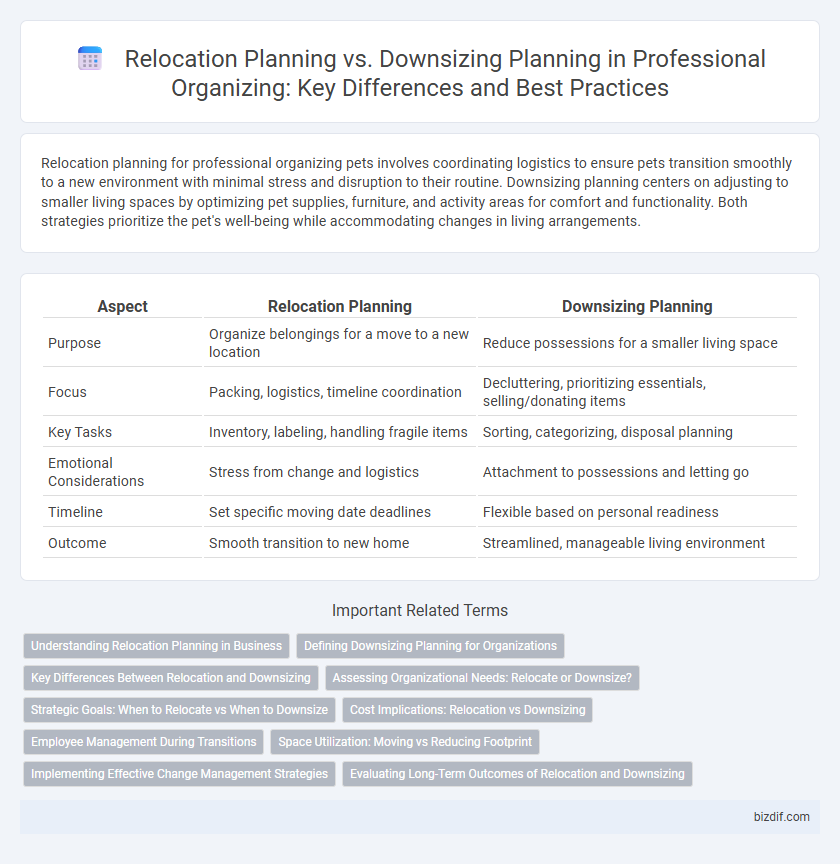Relocation planning for professional organizing pets involves coordinating logistics to ensure pets transition smoothly to a new environment with minimal stress and disruption to their routine. Downsizing planning centers on adjusting to smaller living spaces by optimizing pet supplies, furniture, and activity areas for comfort and functionality. Both strategies prioritize the pet's well-being while accommodating changes in living arrangements.
Table of Comparison
| Aspect | Relocation Planning | Downsizing Planning |
|---|---|---|
| Purpose | Organize belongings for a move to a new location | Reduce possessions for a smaller living space |
| Focus | Packing, logistics, timeline coordination | Decluttering, prioritizing essentials, selling/donating items |
| Key Tasks | Inventory, labeling, handling fragile items | Sorting, categorizing, disposal planning |
| Emotional Considerations | Stress from change and logistics | Attachment to possessions and letting go |
| Timeline | Set specific moving date deadlines | Flexible based on personal readiness |
| Outcome | Smooth transition to new home | Streamlined, manageable living environment |
Understanding Relocation Planning in Business
Relocation planning in business involves strategic coordination of logistics, asset management, and employee transition to ensure minimal disruption and cost-efficiency. It requires detailed assessment of site selection, inventory control, and timeline adherence to maintain operational continuity. Effective relocation planning integrates communication strategies and risk management to optimize productivity during the move.
Defining Downsizing Planning for Organizations
Downsizing planning in organizations focuses on systematically reducing physical or operational resources to enhance efficiency and cut costs, often involving inventory assessment and space optimization. It requires strategic evaluation of essential assets, employee roles, and workflows to maintain productivity despite reduced capacity. Unlike relocation planning, which centers on moving assets to a new location, downsizing prioritizes minimizing volume while preserving core functionality and organizational goals.
Key Differences Between Relocation and Downsizing
Relocation planning centers on coordinating logistics, such as hiring movers, scheduling transfers, and managing timelines to move belongings efficiently to a new home or office. Downsizing planning emphasizes decluttering, prioritizing essential items, and optimizing storage solutions to reduce volume before the move. The key difference lies in relocation focusing on the physical move itself, while downsizing prioritizes minimizing possessions to facilitate a smoother transition.
Assessing Organizational Needs: Relocate or Downsize?
Assessing organizational needs involves a thorough evaluation of space requirements, budget constraints, and long-term goals to determine whether relocation or downsizing is the optimal strategy. Key factors include analyzing current inventory, workflow efficiency, and employee capacity to ensure alignment with future operational demands. Strategic planning tools and professional organizing methods enable businesses to make informed decisions that enhance productivity and cost-effectiveness.
Strategic Goals: When to Relocate vs When to Downsize
Strategic goals play a crucial role in deciding whether to pursue relocation or downsizing during professional organizing. Relocation planning is ideal when the objective is to access better opportunities, enhance lifestyle, or accommodate growth, requiring comprehensive logistical coordination and space optimization. Downsizing planning focuses on simplifying living spaces, reducing clutter, and minimizing maintenance, which aligns with goals of financial savings, stress reduction, and adaptability to changing life circumstances.
Cost Implications: Relocation vs Downsizing
Relocation planning typically involves higher upfront costs such as hiring movers, transporting belongings, and setting up utilities in a new location. Downsizing planning often reduces expenses by minimizing storage needs, selling unused items, and lowering housing costs through smaller living spaces. Evaluating cost implications in both strategies helps optimize budgets by balancing moving expenses against long-term savings from reduced belongings and space.
Employee Management During Transitions
Effective employee management during relocation planning involves clear communication, role reassignment, and relocation support to maintain productivity and morale. Downsizing planning requires sensitive handling of workforce reductions, transparent communication, and outplacement services to support affected employees. Both transition strategies benefit from tailored employee engagement to minimize disruption and foster a positive organizational culture.
Space Utilization: Moving vs Reducing Footprint
Relocation planning emphasizes optimizing space utilization by efficiently arranging belongings within a new environment, ensuring seamless transitions and functional layouts. Downsizing planning focuses on reducing the footprint through strategic decluttering and minimizing possessions to enhance organization and simplify living spaces. Both approaches require tailored strategies to maximize spatial efficiency based on the specific goals of moving or reducing volume.
Implementing Effective Change Management Strategies
Implementing effective change management strategies during relocation planning involves structured communication, clear goal setting, and employee engagement to minimize disruption and ensure smooth transitions. In downsizing planning, strategies prioritize transparent dialogue, emotional support, and phased implementation to manage workforce reductions sensitively and maintain morale. Both approaches require tailored plans that address unique challenges while fostering adaptability and resilience among stakeholders.
Evaluating Long-Term Outcomes of Relocation and Downsizing
Relocation planning emphasizes logistical coordination and adapting to new environments, while downsizing planning focuses on reducing possessions to create more efficient living spaces. Evaluating long-term outcomes of relocation involves assessing the impact on lifestyle, commute, and community integration, whereas downsizing outcomes prioritize stress reduction, financial savings, and simplified maintenance. Both strategies require a detailed analysis of future needs to ensure sustainable, beneficial transitions.
relocation planning vs downsizing planning Infographic

 bizdif.com
bizdif.com